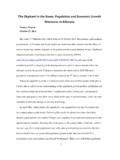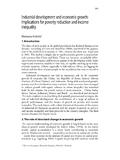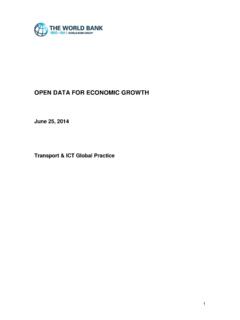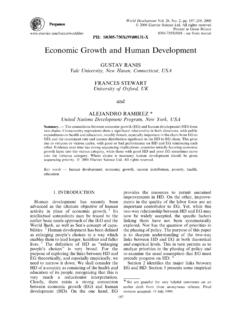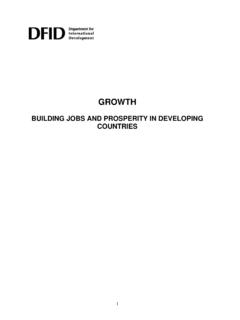Transcription of Reducing income inequality while boosting …
1 economic Policy Reforms 2012 Going for growth OECD 2012181 PART II Chapter 5 Reducing income inequality while boosting economic growth : Can it be done?This chapter identifies inequality patterns across OECD countries and provides newanalysis of their policy and non-policy drivers. One key finding is that education andanti-discrimination policies, well-designed labour market institutions and large and/orprogressive tax and transfer systems can all reduce income inequality . On thisbasis, the chapter identifies several policy reforms that could yield a double dividendin terms of boosting GDP per capita and Reducing income inequality , and also flagsother policy areas where reforms would entail a trade-off between both Reducing income inequality while boosting economic growth : CAN IT BE DONE?
2 economic POLICY REFORMS 2012: GOING FOR growth OECD 2012182 Summary and conclusionsIn many OECD countries, income inequality has increased in past decades. In somecountries, top earners have captured a large share of the overall income gains, while forothers income has risen only a little. There is growing consensus that assessments ofeconomic performance should not focus solely on overall income growth , but also take intoaccount income distribution. Some see poverty as the relevant concern while others areconcerned with income inequality more generally. A key question is whether the type ofgrowth-enhancing policy reforms advocated for each OECD country and the BRIICS in Goingfor growth might have positive or negative side effects on income inequality .
3 More broadly,in pursuing growth and redistribution strategies simultaneously, policy makers need to beaware of possible complementarities or trade-offs between the two chapter sheds new light on this issue, following up on recent OECD work (OECD,2011). It first highlights differences in income inequality across the OECD and the factorsdriving them, such as cross-country differences in wage and non-wage income inequality ,as well as in hours worked and inactivity. The chapter then provides new analysis of thepolicy and non-policy determinants of overall income inequality , assessing separately thedrivers of labour income inequality and the redistributive role of tax and transfer each case, the analysis identifies win-win policies that can both reduce inequality andpromote economic growth , and also highlights policies that may entail trade-offs betweenthe two policy countries can be divided into five groups according to their patterns ofinequality.
4 For example, in five English-speaking countries (Australia, Canada, Ireland,New Zealand and the United Kingdom) and the Netherlands wages are rather dispersedand the share of part-time employment is high, driving inequality in labour earnings abovethe OECD average. Means-tested public cash transfers and progressive household taxesreduce overall income inequality , but it remains above the OECD average. At the other endof the scale, four Nordic countries and Switzerland all have comparatively low labourincome inequality because wage dispersion is narrow and employment rates are transfers tend to be universal and are thus less redistributive. income inequality forthis group is considerably below the OECD chapter also presents new empirical analysis which shows that althoughtechnological change and globalisation have played a role in widening the distribution oflabour income , the marked cross-country variation is likely due to differences in policiesand institutions.
5 This leads to the following conclusions about policies and institutions: Education policies matter. Policies that increase graduation rates from upper secondaryand tertiary education and that also promote equal access to education help reduceinequality. Well-designed labour market policies and institutions can reduce inequality . A relativelyhigh minimum wage narrows the distribution of labour income , but if set too high it mayreduce employment, which dampens its inequality - Reducing effect. Reducing income inequality while boosting economic growth : CAN IT BE DONE? economic POLICY REFORMS 2012: GOING FOR growth OECD 2012183arrangements that strengthen trade unions also tend to reduce labour earningsinequality by ensuring a more equal distribution of earnings.
6 Job protection reforms thatmake permanent and temporary contracts more even in their provisions lower incomeinequality through smaller wage dispersion and also possibly via higher employment. Removing product market regulations that stifle competition can reduce labour incomeinequality by boosting employment. The empirical evidence for the link betweenproduct market reform and the dispersion of earnings is rather mixed. Policies that foster the integration of immigrants and fight all forms of discriminationreduce inequality . Tax and transfer systems play a key role in lowering overall income inequality . Threequarters of the average reduction in inequality they achieve across the OECD is due totransfers. However, the redistributive impact of cash transfers varies widely acrosscountries, reflecting both the size and progressivity of these transfers.
7 In some countries( , the United Kingdom to a lesser extent), cash transfers are small in size buthighly targeted on those in need. In some others ( or Germany), large transfersredistribute income mainly over the life-cycle rather than across individuals, and theirprogressivity is often low. Of the various types of taxes, the personal income tax tends to be progressive, whilesocial security contributions, consumption taxes and real estate taxes tend to beregressive. But progressivity could be strengthened by cutting back tax expenditures thatbenefit mainly high- income groups ( relief on mortgage interest). In addition,removing other tax reliefs such as reduced taxation of capital gains from the sale of aprincipal or secondary residence, stock options and carried interest would increaseequity and allow a growth -enhancing cut in marginal labour income tax rates.
8 It wouldalso reduce tax avoidance instruments for top- income findings, combined with past OECD and other work on the gross domesticproduct (GDP) per capita effects of policies and institutions which underpins thegrowth-enhancing reform recommendations made in Going for growth highlight theexistence of both complementarities and trade-offs between Reducing inequality andpromoting economic growth : Many policies entail a double dividend as they reduce income inequality while at thesame time boosting long-run GDP per capita. Examples include facilitating theaccumulation of human capital, making educational potential less dependent onpersonal and social circumstances, Reducing labour market dualism or promoting theintegration of immigrants and fostering female labour market participation.
9 Concerningtaxation, Reducing tax expenditures, for instance for investing in housing, contributes toequity objectives while also allowing a growth -friendly cut in marginal tax rates. By contrast, several policies may entail a trade-off between Reducing income inequalityand raising GDP per capita. For instance, administrative extensions of collective wageagreements may reduce wage earnings dispersion among workers, but if they set labourcosts at too-high levels for some employers they may harm competition and productivityand possibly reduce employment. Shifting the tax mix to less-distorting taxes inparticular away from labour and corporate income taxes towards consumption and realestate taxes would improve incentives to work, save and invest, but could undermineequity.
10 Cash transfers targeted to lower incomes can be used to ease this trade Reducing income inequality while boosting economic growth : CAN IT BE DONE? economic POLICY REFORMS 2012: GOING FOR growth OECD 2012184 Finally, some policies aimed at boosting GDP per capita have an uncertain impact onincome inequality . For instance, avoiding too-high and long-lasting unemploymentbenefits may raise employment over the long run but also widen the distribution ofincome among workers, with an ambiguous net effect on inequality . The same holds asregards keeping minimum wages at moderate inequalityHow does one measure income inequality ? According to a report by theStiglitz-Sen-Fitoussi Commission (Stiglitz et al., 2009), the most comprehensive incomeconcept is household disposable income that has been adjusted for publicly-providedin-kind transfers, such as public spending on education and health care.










